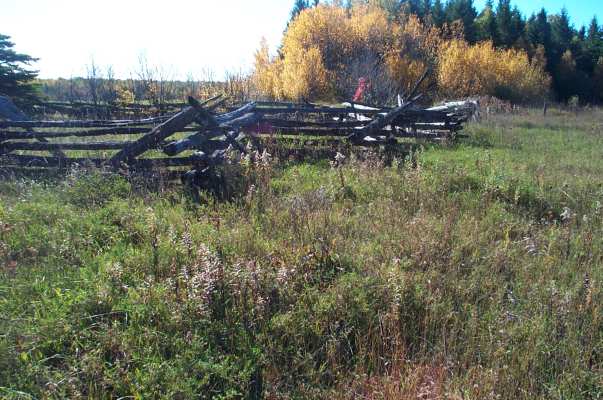by Diane Schivera
  |
When fields are neglected:
Perennial weeds begin to appear,
Woody species invade,
Soil becomes acidic,
Frost brings large rocks to the surface.
When looking for ways to return fields to production, always start with methods that are most likely to succeed and are least costly.
The least costly and most environmentally sound solution that will build organic matter in the soil is to use temporary fence and an animal that will consume the plants available. The result will be manured fields that have been returned to edible species. The trick is using the correct animals and having enough time for the change to happen.
Cows are fussy eaters, and maintaining their ration to keep production stable is usually important. Goats will eat more browse or bushy plants and small trees. Sheep eat pasture close to the ground if left on the pasture long enough, and this could help to eliminate some weeds. Pigs will till the ground if left for long periods. Poultry will also do a great job of breaking up soil and eliminating all plant matter if left long enough.
Steps to Take
- Assess the condition of the field, your goals and your finances and equipment.
- Get a soil test.
- Complete the pasture soil assessment sheet in the ATTRA technical note Assessing the Pasture Soil Resource. (This sheet addresses other factors of soil health, from compaction to earthworm populations. It is available at attra.ncat.org/attra-pub/pastsoil.html.)
- Lime and fertilize
- For hay or pasture, fence the area to be renovated and put animals on the field.
- For hay, mow the field with a rotary mower to remove problem plants by cutting them before they set viable seed.
- Remove rocks and stumps
- Till to control tenacious, perennial weeds, such as bedstraw, and then seed. The best time to seed is in May or in the first three weeks of August, when seed will survive and compete with weeds better. Choose desirable species, and seed using the correct rate and method. The species choice will depend partly upon winter hardiness, soil drainage and pH (see Table below). Most legumes need good drainage, pH, fertility and species-specific harvest management for pasture halage or hay.
Alternatives to seeding with machinery exist. Frost seeding is spreading seed in late winter or early spring after the snow is gone and when the soil surface is alternately opened by frost at night, then closed by the heat of the day. This works best with the larger round legume seeds, although grass seeds will work sometimes. The price of the seed is a factor to consider.
Animal seeding uses animals’ hooves to work seed into soft, wet, mostly bare soil. The animals are removed before the soil is damaged. This is an excellent way to repair areas that have been over grazed or been used as a winter paddock.
Seeding rates for frost and animal seeding are:
Red clover 4-6 lbs./acre
White/Alsike clover 3-4
Rye 8-15
Birdsfoot trefoil 4-6
Orchard grass 3-4
Intense rotation or mob stocking can also be used to renovate pastures. This technique uses small paddocks that provide little ability for animals to be selective. The intense grazing must be followed by good management that has a defined grazing period and rest period, uniform utilization and flexibility! A great source of information about this Voisin method of pasture management is the book Greener Pasture on Your Side of The Fence, by Bill Murphy.
Harvesting has a role in good pasture management. One possibility is harvesting the first cut and allowing grazing in July and August.
The earlier cut makes forage with higher protein, less fiber, more sugars and good carbohydrates.
Other techniques that help keep the pasture healthy are:
- Watering only at watering sites.
- Placing mineral feeders and additional feed at other places in the paddocks.
- Limiting shade.
- Moving animals once or twice each day.
With regular mowing and good pasture management, you will have a good field within three to four years. The species in the fields will improve, and clovers (from seed that has been in the soil for years) will become a more substantial part of the sward, since clovers respond to the increase in sunlight when grasses don’t overwhelm them. The goal is to balance yield, stand life and quality.
If this looks like more work than you will be able to manage for all your pasture acreage in one season, consider breaking it up. You can leave part of your permanent pasture as it is for the first year. Section off one part and begin by mob stocking, if necessary, to correct extreme weed problems. Then, in the next year for that area or in the first year for a paddock where the weeds aren’t too bad, begin using temporary fencing to divide the area into smaller sections. Using the Voisin method of rotation will improve your pastures with time.
Resource: “This Old Hayfield,” by Rick Kersbergen. University of Maine Cooperative Extension Bulletin #2491.